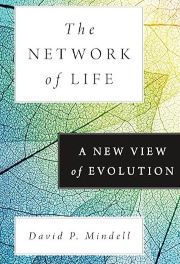The Network of Life: A New View of Evolution

David P. Mindell
Princeton University Press, £22.00
This is an outstanding and thought-provoking book. Traditional vertical evolution in the style of Darwinism is a family tree with species evolving in a branching mode. However, horizontal evolution is the focus of this book. It involves interbreeding and genetic recombination, the merger of species, horizontal gene transfer, and co-evolution.
Using this horizontal approach to evolution, it will be possible to understand, for example, the threats that climate change will place on environmental and human health, for which analysis can be carried out most effectively with the use of artificial intelligence and machine learning. It is argued that this will hopefully lead to evolutionary innovation, and this will be particularly important in healthcare and for humans as they become fitter.
There is a good analysis of the human holobiont, which includes the microbiomes that associate with humans. In many ways much of what is said has been readily available for a long time, but the important contribution is the way in which the components are brought together. The origin of life is critical to the thinking in this book and there is a good analysis of this topic across it. Whereas the views expressed in the book are often radical, they are supported by good quality and modern evidence in the notes. This publication is multidisciplinary and will appeal to those with expertise, but it should be also easy to read for the layman.
Professor Jim Lynch FRSB
Reviewed by Professor Jim Lynch OBE FRSB, Distinguished Professor Life Sciences Emeritus, Centre for Environment and Sustainability, University of Surrey


